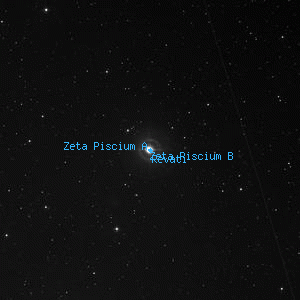Revati

Overlaid DSS image of Revati, 60' x 60' with north at top and west to the right
Aladin viewer for the region around Revati
Zeta Piscium, ζ Psc, 86 Psc
Σ 100, WDS J01137+0735
Σ 100, WDS J01137+0735
| Type | Multiple Star |
|---|---|
| Magnitude | 4.9 | Right Ascension | 1h 13' 43.9" (2000) |
| Declination | 7° 34' 31" N |
| Constellation | Pisces |
| Description | Quintuple A/B are 5.2/6.1 23" |
Observing Notes
Andrew Cooper
Nov 7, 2020 Waikoloa, HI (map)
20cm f/6 Newtonian, Cave Astrola @ 76x
Seeing: 6 Transparency: 6 Moon: 0%
A pretty binary, the 5th magnitude white primary ζPsc A sits 23" southest of the 6th magnitude pale yellow ζPsc B, 88 Psc is 38' southeast
The description I was reading in Sky Safari indicated this pair is an optical double, possibly other sources note this. But this may not be true... Checking the Gaia DR2 data shows the pair is likely physically associated. A has a parallax of 24.71mas while B exhibits 24.25mas. The proper motions likewise seem to match up with at at 143.25mas/yr in RA and -53.28mas/yr in dec, while B moves 139.35mas/yr in RA and -53.37mas/yr in dec
Andrew Cooper
Oct 14, 2020 Waikoloa, HI (map)
20cm f/6 Newtonian, Cave Astrola @ 76x
Seeing: 7 Transparency: 6 Moon: 0%
An excellent multiple star first appearing as a lovely binary in the eyepiece, a 5.2 magnitude pale-yellow primary with a 6.1 magnitude ivory companion 23" northeast, accidentally found while pointing at Mars during the 2020 opposition
Some sources including SkySafari note that this is an optical double only while Gaia DR2 data shows this to be a gravitationally bound system with a parallax of 24.71mas for A and 24.25mas for B, proper motions likewise match up with A at 143.25mas/yr in RA and -53.28mas/yr in dec, B at 139.36mas/yr in RA and -53.37mas/yr in dec
A is binary of two type A subgiants with a separation of 0.15", B is a spectroscopic binary with C a 12.2 magnitude 1" from B
Captain William Henry Smyth
Nov 18, 1834 No. 6 The Crescent, Bedford, England (map)
150mm f/17.6 refractor by Tully 1827
A neat double star. A 6, silver white; B 8, pale grey. This fine and easy object was classed H IV 8, and it is on a bend of the band which joins the two Fishes; it constitutes Piazzi's Nos. 16 and 17, of Hora 1, and by a reduction of his apparent places, the following somewhat vague comparison is obtained:H. Pos. 67°23' Dist. 22".19 Ep. 1779'80whence, after an interval of sixty years, my observations point out but little change, and even that little is chargeable to errors of observation: every honest and careful statement, however, is increasing in value with the improvement of instruments.
P. 63°20' 19".60 1800
[WDS 63° 23".20 2018]
The large star may be variable. Ptolemy calls it δ in lustre, and he is followed by Ulugh Beigh, Tycho Brahe, and Hevelius. Mr. Baily says, "This star is stated, in the British Catalogue, to be of the 4th magnitude; but in the original observations it is nowhere stated to be more than the 5th; and in one place it is marked as the 6th, but afterwards altered to the 5th, which I have retained." A slight proper motion in space is assigned, of these values :P .... RA -0".01 Dec. +0".03ζ Piscium slightly precedes an occult line drawn between β Ceti and α Trianguli, and is nearly in the mid-distance.
B .... +0".19 -0".06
A .... +0".17 -0".09
T .... +0".02 +0".04
[Gaia DR2 +0".14325 -0".05328]― A Cycle of Celestial Objects Vol II, The Bedford Catalogue, William Henry Smyth, 1844
Other Data Sources for Revati
Associated objects for Revati
Nearby objects for Revati
7 objects found within 120'
| 88 Piscium | e Piscium | HD 7047 |
| NGC 437 | NGC 485 | |
| Zeta Piscium B |
Credits...
Drawings, descriptions, and CCD photos are copyright Andrew Cooper unless otherwise noted, no usage without permission.
A complete list of credits and sources can be found on the about page
Revati